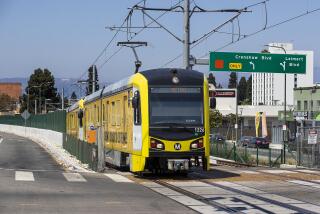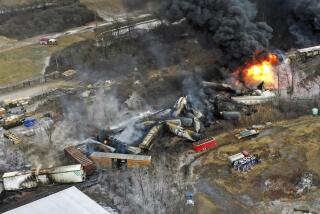Metrolink pushing forward with system designed to prevent crashes
More than three years after the deadly Metrolink crash in Chatsworth, the commuter railroad is forging ahead with the most sophisticated collision avoidance system in the country despite efforts in Congress to relax requirements to install the safety improvement nationwide.
Metrolink already has made substantial progress developing its $201-million positive train control system, which uses an array of electronic gear to monitor and, if necessary, take control of trains to prevent collisions and derailments.
The vast majority of track-side communication stations and radio antennas for the new system have been installed along the railroad’s 512 miles of track. Other equipment has been added to a group of locomotives, and a sophisticated dispatching system is under development.
Involved in the project are Union Pacific and the Burlington Northern Santa Fe Railway Co., which have spent years working on positive train control. Both companies operate freight trains on the same tracks as Metrolink, which serves six Southern California counties.
The entire system is expected to be operational next year, meaning that Metrolink would be one of the first passenger railroads in the nation to fully deploy a state-of-the-art train control system that marries global positioning technology to computers and digital radio communications.
It also means that Southern California could find itself serving for years as a groundbreaking and isolated safety test lab if Congress decides to postpone the deadline from 2015 to 2020 for installing the technology.
Federal lawmakers are being pressured by influential railroads and transportation organizations that say positive train control is very costly and tricky to install and remains largely unproven in daily operations.
Metrolink officials say they want to complete their system by mid-2013 regardless of any change in the national mandate, which covers 70,000 miles of track used by passenger trains and railroads that haul hazardous materials.
“I don’t think the rollback is justified,” said Richard Katz, chairman of the Metrolink Board of Directors. “This is the most important development in our lifetimes as far as rail safety is concerned. Every year we delay, more people are going to die that don’t have to.”
Congress set a Dec. 31, 2015, deadline for positive train control after a Metrolink train collided head-on with a Union Pacific freight train near the Chatsworth station in September 2008, killing 25 people and injuring more than 130.
The National Transportation Safety Board, which has recommended the use of the collision prevention technology since 1990, concluded that Metrolink’s engineer was text messaging and failed to stop for a red signal. Positive train control’s automated braking system would have prevented the crash and 20 other deadly and costly rail accidents nationwide in the last two decades, investigators said.
To help rebuild public confidence and counter a dismal safety record, Metrolink officials decided to accelerate the installation of the high-tech system in one of the nation’s busiest rail centers.
“I’m confident Metrolink will get there,” said John Fenton, the railroad’s chief executive. “But when you look at where we are today, it’s a massive project given the type of work force, the vendors, the technology issues and the possibility of transforming the industry. There are some real challenges. At this point, without a national strategy, I do have concerns.”
Other passenger lines, freight railroads and transportation organizations contend that more time is needed because of the mandated system’s complexity, the need for uniformity across the U.S. rail network and the high cost — an estimated $12 billion nationally, including $2 billion for commuter operations.
Some rail lines might not be able to afford the systems, which can cost hundreds of millions of dollars each, according to the Assn. of American Railroads and the American Public Transportation Assn., which represents 28 commuter lines.
In addition, railroads are concerned about the availability and reliability of required electronic equipment and a potential shortage of adequately trained installers and maintenance workers. A major impediment, most experts agree, is a lack of the radio frequencies needed for the system’s extensive communications network.
The array of concerns has prompted some federal lawmakers to include the five-year delay in a Republican-drafted transportation bill expected to come before the House as early as this week. The proposed legislation would also allow railroads to develop less costly and complex safety systems along tracks that carry toxic materials.
Although the House bill would need to be reconciled with a very different Senate bill, the deadline change could make it into a final bill, given the bipartisan support it has received.
Metrolink officials say they have federal and state money to build their system, but many other passenger railroads do not know how they will pay for positive train control because government funding has dwindled amid the weak economy.
At the federal level, only about $50 million has been allocated out of $250 million Congress set aside for positive train control projects.
“Budgets are very, very tight, and our capital program is really hurting,” said Jeff Knueppel, assistant general manager and chief engineer for the Southeastern Pennsylvania Transportation Authority. “We’re saying, ‘Stretch it out; allow us to use funds for other, just as important, safety initiatives.’”
Sen. Dianne Feinstein (D-Calif.), who championed the bill that established the 2015 deadline for the crash avoidance systems, is fighting any delay.
Siding with her is Rep. Elton Gallegly (R-Simi Valley), whose district is home to some of the Chatsworth victims. Commuters deserve to know that the trains they ride are equipped to get them to their destinations safely, he said.
Barbara Kloster, whose son Mike was almost cut in half in the crash, is confident that Metrolink officials will try to complete their system early. But she criticized the proposal in Congress to push back the national deadline.
“That’s all right,” Kloster said sarcastically. “Then they can have some more crashes and more dead people and other people who can suffer for the rest of their lives.”
NTSB Chairman Deborah A. P. Hersman noted that railroads were given seven years under the current deadline to deploy the long-recommended systems. “It is disappointing to learn that there may be a delay beyond 2015,” she said.
California’s other Democratic senator, Barbara Boxer, who has favored keeping the present deadline, is waiting for more information from federal regulators about the technological challenges of implementing positive train control nationwide.
As chairwoman of the Senate Environment and Public Works Committee, Boxer will play a key role in writing the final transportation bill. “If it’s not totally ready yet, that’s one thing,” she said. “But if it’s ready to roll, there’s no reason to delay it.”
Despite the national concerns, Metrolink’s pioneering effort is welcomed by operators of many of the nation’s commuter rail systems.
“Hopefully, Metrolink will identify what works and what problems there might be,” said Robert L. Healy Jr., vice president of government affairs for the American Public Transportation Assn. “Hopefully, their experience will reduce the costs for other systems moving forward.”
Weikel reported from Los Angeles and Simon from Washington, D.C.
More to Read
Sign up for Essential California
The most important California stories and recommendations in your inbox every morning.
You may occasionally receive promotional content from the Los Angeles Times.












